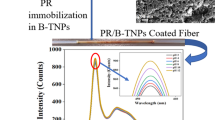Abstract
Thermally stable acid catalyzed mesoporous titania (TiO2) nanomatrices are obtained by sol–gel method for fiber optic pH sensing. These synthesized nanoparticles are annealed at 300 °C, at two time intervals i.e., 1 h and 2 h, characterized with several analytical techniques such as FE-SEM/EDS, AFM, XRD, FTIR, TGA, and Brunauer–Emmett–Teller (BET) analysis. Microscopic analysis shows that synthesized nanoparticles have crack-free, dense and homogeneous surface with low surface roughness (4.4–5.9 nm). EDS mapping confirms the uniform distribution of Ti in all samples. XRD findings revealed the TiO2 anatase phase. BET analysis shows that the mesoporous synthesized TiO2 nanoparticles have surface areas 169 m2/g and average pore diameter 39.2 Å. However, surface area is decreased to 113 and 102 m2/g and average pore diameter increased up to 62.36 and 68.18 Å after 1 h and 2 h heat treatment, respectively. Furthermore, the sensing activity of phenolphthalein (phph) doped mesoporous TiO2 nanoparticles/matrix is found to be high at pH 12 without any leaching/cracking.











Similar content being viewed by others
References
Monkowski AJ, Morrill A, MacDonald NC (2006) Arrayed nanostructured titania functionalized for hydrogen detection. ECS Trans 3(10):493–501
Hasan MM, Haseeb MA, Saidur R, Masjuki HH (2008) Effects of annealing treatment on optical properties of anatase TiO2 thin films. Int J Chem Biol Eng 1(2):92–96
Vardan G, Elisabetta C, Camilla B, Andrea P, Matteo F, Nicola P, Elza B, Mariangela B, Guido F, Giorgio S (2015) Large surface area biphase titania for chemical sensing. Sens Actuators B 209:1091–1096
Liu S, Chen X, Chen X (2006) Preparation of N-doped visible-light response nanosize TiO2 photocatalyst using the acid-catalyzed hydrolysis method. Chin J Catal 27:697–702
Kim CK, Nakaso K, Bin X, Okuyama K, Shimada M (2005) A new observation on the phase transformation of TiO2 nanoparticles produced by a CVD method. Aerosol Sci Technol 39:104–112
Acosta DR, Martınez A, Magana CR, Ortega JM (2005) Electron and Atomic Force Microscopy studies of photocatalytic titanium dioxide thin films deposited by DC magnetron sputtering. Thin Solid Films 490:112–117
Hu Y, Tsai HL, Haung CL (2003) Phase transformation of precipitated TiO2 nanoparticles. Mater Sci Eng A 344:209–214
Bakardjieva S, Stengl V, Szatmary L, Subrt J, Lukac J, Murafa N, Niznansky D, Cizek K, Jirkovsky J, Petrova N (2006) Transformation of brookite-type TiO2 nanocrystals to rutile: correlation between microstructure and photoactivity. J Mater Chem 16:1709–1716
Yao N, Yeung KL (2008) Anomalous crystal growth on TiO2 thin film induced by the AFM tip. Ind Eng Chem Res 47:9195–9200
Pecchi G, Ryes P, Lopez T, Gomez R, Moreno A, Fierro JLG (2002) Effect Of chlorine precursor in surface and catalytic properties of Fe/Tio2 catalysts. Bol Soc Chil Quim 47:191–197
Islam S, Bidin N, Riaz S, Krishnan G, Naseem S (2016) Sol–gel based fiber optic pH nanosensor: structural and sensing properties. Sens Actuators A 238:8–18
Fanya I, Monika S, Rolan M, Behnam B, Peter F, Nicholas JG (2011) Strength of interactions between immobilized dye molecules and sol–gel matrices. Analyst 136:807–815
Chris M, Thomas MB, Brian DM (2000) Infuence of the surface polarity of dye-doped sol–gel glass flms on optical ammonia sensor response. Thin Solid Films 368:105–110
Aleksandra L, Ines O, Ivana M, Otto SW (1998) pH optical sensors based on sol–gels: chemical doping versus covalent immobilization. Anal Chim Acta 367(1–3):159–165
Paola AD, Bellardita M, Palmisano L (2013) Brookite, the least known TiO2 photocatalyst. Catalysts 3:36–73
Samira B, Kamyar S, Sharifah BAH (2013) Synthesis and characterization of anatase titanium dioxide nanoparticles using egg white solution via sol–gel method J Chem 2013:5848205
Othman SH, Rashid SA, Mohd Ghazi TI, Abdullah N (2010) Effect of postdeposition heat treatment on the crystallinity, size, and photocatalytic activity of nanoparticles produced via chemical vapour deposition J Nanomater 2010:10512785
Tabrizi BN (2014) Thermal treatment effect on structural features of mechano-synthesized fluorapatite–titania nanocomposite: a comparative study. J Adv Ceram 3(1):31–42
Nyamukamba P, Tichagwa L, Greyling C (2012) The influence of carbon doping on TiO2 nanoparticle size, surface area, anatase to rutile phase transformation and photocatalytic activity. Mater Sci Forum 712:49–63
Altar AS, Ghamsari MS, Hajiesmaeilbaigi F, Mirdamadi S (2008) Modifier ligands effects on the synthesized TiO2 nanocrystals. J Mater Sci 43:1723–1729
Mathew S, Prasad AK, Benoy T, Rakesh PP, Hari M, Libish TM, Radhakrishnan P, Nampoori VPN, Vallabhan CPG (2012) UV-visible photoluminescence of TiO2 nanoparticles prepared by hydrothermal method. J Fluoresc 22(6):1563–1569
Ranga RA, Dutta V (2007) Low-temperature synthesis of TiO2 nanoparticles and preparation of TiO2 thin films by spray deposition. Sol Energy Mater & Sol Cells 91:1075–1080
Islam S, Bidin N, Riaz S, Rahman AR, Naseem S, Marsin MF (2015) Mesoporous SiO2–TiO2 nanocomposite for pH sensing. Sens Actuators B 221:993–1002
Acknowledgements
The authors like to express their gratitude to the Government of Malaysia through grant FRGS vote 03E89 for the financial support in this project. Thanks are also due to UTM through RMC for awarding the Postdoctoral fellowship to the first author.
Author information
Authors and Affiliations
Corresponding author
Ethics declarations
Conflict of interest
The authors declare that they have no conflict of interest.
Additional information
Highlights
-
Mesoporous titania (TiO2) nanomatrices are synthesized by sol–gel method for fiber optic pH sensing.
-
Crack-free, dense and homogeneous surface with low surface roughness (4.4–5.9 nm) is reported. Uniform distribution of Ti is confirmed by EDS mapping.
-
XRD findings revealed the TiO2 anatase phase.
-
High surface area 169 m2/g has capability for good sensing response.
-
Phenolphthalein (phph) doped TiO2 matrix is found to be highly senstive at pH 12 without any leaching/cracking.
Rights and permissions
About this article
Cite this article
Islam, S., Bakhtiar, H., Bidin, N. et al. Sol–gel based thermally stable mesoporous TiO2 nanomatrix for fiber optic pH sensing. J Sol-Gel Sci Technol 86, 42–50 (2018). https://doi.org/10.1007/s10971-018-4604-3
Received:
Accepted:
Published:
Issue Date:
DOI: https://doi.org/10.1007/s10971-018-4604-3




